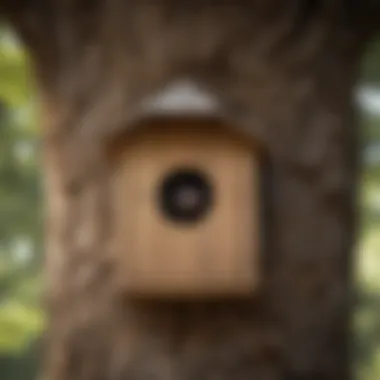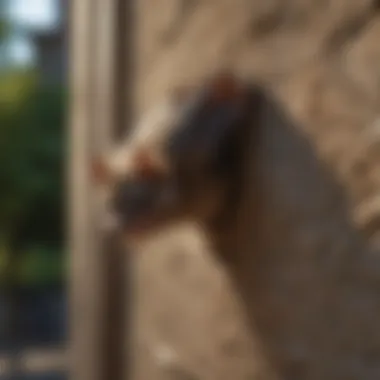Effective Strategies for Bat Removal from Homes


Intro
Bats are often perceived as pests, yet they play an essential role in our ecosystem. They are biologically fascinating creatures, capable of consuming vast quantities of insects. However, when they invade residential spaces, they can cause various issues. This article aims to provide an in-depth understanding of effective strategies for bats removal while emphasizing humane approaches. It is crucial for homeowners to be equipped with knowledge not just for the removal process but also to prevent future occurrences.
Understanding Pests
Definition of Pests
A pest is typically defined as an organism that causes harm to humans, their property, or their environment. In the case of bats, their presence in homes or attics can lead to structural damage or health concerns through the transmission of diseases. Understanding this definition allows homeowners to take appropriate actions regarding infestations.
Importance of Pest Identification
Accurate pest identification is key. It helps in determining whether the detected creatures are indeed bats or perhaps another type of animal that might require different handling. Furthermore, identifying their species can inform the best method for removal. For instance, the Little Brown Bat and the Big Brown Bat are common in North America, differing in behavior and roosting habits.
Prevention Techniques
Home and Garden Preventative Measures
Preventing bats from accessing your property is fundamental to managing these creatures. Here are a few practical steps:
- Seal Entry Points: Inspect your property and seal any cracks or openings larger than a quarter inch. Pay special attention to roof eaves, vents, and chimneys.
- Manage Outdoor Lighting: Bats are attracted to insects, which are drawn to lights. Reducing unnecessary outdoor lighting may minimize insect populations.
- Maintain Landscaping: Keep shrubs and trees trimmed to reduce hiding spots for bats. If possible, opt for bat-repellent plants such as marigolds and lemongrass.
Seasonal Prevention Tips
Bats are more likely to enter homes during specific seasons.
- Spring & Summer: This is their active season. Regular checks on the exterior of your home during these months can help you spot potential entry points.
- Fall: As they seek out warm places for hibernation, sealing points of entry before winter is crucial. Consider professional inspections.
Eco-Friendly Pest Control Solutions
Overview of Sustainable Practices
When dealing with bats, emphasizing humane solutions is key. Eco-friendly practices not only protect wildlife but also align with sustainability. Some basic principles are:
- Exclusion over Eviction: Rather than killing bats, aim to exclude them with one-way doors, allowing them to exit while preventing re-entry.
- Use Sound Deterrents: Employ sound devices that emit frequencies irritating to bats but inaudible to humans.
Natural Remedies and Their Effectiveness
Though fewer in number, there are some natural remedies that homeowners can deploy effectively.
- Cinnamon Oil: This is said to have properties that bats do not find appealing. Spraying a mixture of cinnamon oil with water in common areas can deter them.
- Peppermint Oil: Much like cinnamon, peppermint oil is another deterrent. Place cotton balls soaked in the oil around areas where bats may enter.
Epilogue
Bats can become an unwelcome presence in a household, but with informed strategies, their removal and prevention can be effectively managed. Homeowners should prioritize humane treatment and proactive measures to ensure a balanced coexistence with wildlife.
Preamble to Bats
Understanding bats is crucial for any property owner facing their presence. Bats play a significant role in nature. They help with pest control, pollination, and seed dispersal. Hence, recognizing their importance allows homeowners to appreciate their contributions, even when removal becomes necessary. This section provides insight into bat ecology and urban species.
Understanding Bat Ecology
Bats belong to the order Chiroptera and are the only mammals capable of sustained flight. They are highly adaptable creatures found in various habitats, from forests to urban landscapes. Bats are nocturnal, meaning they are most active at night when they hunt for insects, fruit, or nectar.


Bats contribute to ecological balance. One bat can eat thousands of insects in a single night. This attribute makes them valuable for controlling pest populations, which might otherwise affect crops and gardens. Understanding their habits, roosting preferences, and migration patterns is essential for effective management strategies. Engaging with local wildlife resources can provide invaluable information on how to coexist peacefully with these creatures.
Common Bat Species in Urban Areas
Urban environments are increasingly home to several bat species. Some of the most common include the Little Brown Bat, Big Brown Bat, and the Mexican Free-tailed Bat. Each of these species exhibits unique behaviors that affect their interactions with human spaces.
- Little Brown Bat: Often found in buildings, these bats thrive on insects. They are notable for their small size and critical role in controlling insect populations.
- Big Brown Bat: These bats are larger and sometimes roost in attics or under eaves. They are highly adaptable and can forage in city landscapes effectively.
- Mexican Free-tailed Bat: Recognizable by their long tails, these bats tend to form large colonies under bridges and in buildings. Their patterns of evening flight are a common sight in urban areas.
Understanding which species are present in your area helps formulate specific strategies for removal while maintaining ecological integrity.
"Bats are fascinating creatures that blend into urban life, often unnoticed until they become a problem."
In summary, this section on bats enhances the reader’s perspective on these animals, emphasizing their ecological roles and adaptations to urban life. Each homeowner should consider these factors before seeking removal, as solutions may vary significantly based on the species in question.
Reasons for Bat Presence
Understanding why bats choose to inhabit certain areas is essential for developing effective removal strategies. This section focuses on Natural Habitats and Urban Encroachment and Attractants for Bats. Knowing their preferences helps in creating environments that are less appealing to these creatures, leading to better management and exclusion outcomes.
Natural Habitats and Urban Encroachment
Bats traditionally thrive in natural habitats, such as woodland areas, caves, and old trees. They require roosting sites that provide protection from predators and harsh weather. As urban development increases, these natural environments are lost. Consequently, bats often adapt to urban areas, seeking shelter in attics, eaves, and even behind siding. Their adaptability is remarkable, but it also poses challenges for homeowners.
Urban encroachment alters the landscape, potentially providing bats with new nesting and roosting opportunities. Old buildings, for instance, might have crevices and holes that serve as perfect hiding spots. Moreover, cities often have abundant food sources, mainly insects, making them ideal for bats.
To combat this, homeowners should first understand the habitat loss that has forced bats into their properties. Recognizing that these creatures are not merely pests but part of the ecological balance can lead to more humane strategies for handling their presence.
Attractants for Bats
Several factors can attract bats to residential areas. Understanding these can aid in prevention. Key factors include:
- Food Availability: Bats primarily feed on insects. Areas with high insect populations, especially near stagnant water, are more likely to attract bats. Homeowners might inadvertently create ideal conditions by not managing standing water effectively.
- Shelter: As noted, bats look for safe and secure locations for roosting. Houses with gaps, poorly sealed vents, and unmaintained attics can provide these secure spots. Even small openings can allow bats access, leading to colonization.
- Lighting Conditions: Many bats are nocturnal and use low-light conditions to hunt for insects. Well-lit areas might attract more insects, drawing bats closer to homes.
- Landscape Features: Trees and landscaping that encourage insect populations can also lead bats to residential properties. Garden plants and flowering shrubs can be beneficial for attracting insects, which might in turn attract bats.
By identifying and addressing these attractants, homeowners can significantly reduce the likelihood of bats taking up residence in their homes. This requires proactive measures such as sealing entry points, modifying landscaping, and managing food sources.
Important Note: Creating a bat-friendly environment can be beneficial, as bats play a significant role in controlling insect populations. However, inappropriate structures or food management can encourage them to invade homes instead of seeking suitable natural habitats.
Health Risks Associated with Bats
Understanding the health risks associated with bats is crucial for homeowners. While bats play an important role in our ecosystem by controlling insect populations, their presence in urban areas can pose various health challenges. It is essential to be informed about these risks to not only safeguard our health but also to approach bat management with knowledge and precaution.
Disease Transmission
Bats are known carriers of several diseases that can be harmful to humans. One of the most concerning is rabies, a viral infection that can be fatal if not treated promptly. Bats can transmit this disease through bites or scratches. If a bat comes into contact with pets, the risk of rabies transmission increases.
Moreover, the presence of bats can raise concerns about other zoonotic diseases, such as histoplasmosis. This is a respiratory disease caused by inhaling spores from the fungus that grows in bat droppings, also known as guano. The fungus thrives in warm, moist environments, making attics and other bat roosting areas potential sources for disease. Individuals, especially those with compromised immune systems, should take extra precautions when dealing with bat droppings.
"It is important to seek medical advice if a bat is found in your home. Exposure to bats should be taken seriously."
Potential Allergens and Bat Guano
Bat guano presents not only a health hazard but also can cause allergic reactions. The droppings can harbor allergens which may trigger respiratory issues in sensitive individuals. Prolonged exposure to contaminated environments may lead to chronic respiratory problems. Cleaning areas where bats have roosted must not be taken lightly.
Additionally, the high acidity of bat guano can damage property. It can rot wood and corrode metal surfaces, leading to costly repairs. Therefore, understanding the implications of bat presence is vital, particularly for those with respiratory issues or allergies.
In summary, the health risks associated with bats warrant vigilance and careful consideration. Homeowners must address these issues with a comprehensive approach to remove and prevent bats from becoming a health hazard.


Humane Exclusion Techniques
In the context of removing bats from residential properties, humane exclusion techniques play a crucial role. These methods prioritize the well-being of bats while effectively encouraging them to leave. Successful implementation of these techniques not only aligns with ethical standards but also fosters a long-term resolution to the issue of bat presence in and around homes. By understanding the behaviors and habitats of bats, homeowners can make informed decisions that focus on prevention rather than eradication.
Inspection and Identification
Before undertaking any action, it is essential to conduct a thorough inspection of your property. This examination should be systematic, focusing on areas such as roofs, attics, and eaves where bats are likely to roost. Look for signs of bat activity, such as droppings (guano), urine stains, and noise emanating from hidden spaces.
Identifying the species of bat present can also be beneficial. For instance, the little brown bat and the big brown bat are common in urban areas. Familiarity with these species helps in choosing the right exclusion methods tailored to their specific behaviors and roosting preferences. Make sure to observe the bats’ activity patterns, noting peak times for their appearances, which typically occur in the evening or at dusk.
Sealing Entry Points
After identifying how bats enter your property, sealing these entry points is a critical step in the exclusion process. Entry points can include gaps in the roof, poorly fitted vents, and even small cracks in walls. It is advisable to use durable materials such as metal flashing or caulk to securely close these openings.
Take care to ensure that all potential exit points are sealed before implementing exclusion methods. If not, bats may find alternative routes back into your home. Remember that bats often return to the same roosting sites year after year, making it crucial to eliminate these entry points before bats attempt to re-inhabit them.
Installation of Bat Exclusion Devices
Once the inspection is complete and entry points are sealed, the installation of bat exclusion devices can begin. These devices enable bats to exit while preventing their re-entry. One effective option is the one-way door system. This device allows bats to leave the roost but makes it impossible for them to return.
It is critical to install these devices during late spring or early summer when bat populations are often more active. Be cautious not to seal bats inside your property, as this could lead to stress on the animals and possible health risks from urine or droppings. Ensure you monitor the situation closely; once you are confident that all bats have left, you can remove the exclusion devices safely.
Humane exclusion techniques not only protect the welfare of bats but also promote long-lasting solutions to bat infestations.
Adopting these methods requires patience and diligence. By prioritizing humane strategies, homeowners can effectively manage bat presence without resorting to harmful extermination practices.
Repellent Strategies
Repellent strategies are vital in managing bat populations effectively and humanely. Understanding these methods can provide a less intrusive way to discourage bats from taking residence on your property. Homeowners often find themselves in need of solutions that do not harm the bats while still addressing the issue. Implementing repellent strategies serves two primary purposes: it can enhance comfort for residents and also ensure that bats are not unduly disturbed. These methods include ultrasonic devices and using natural odor repellents.
Ultrasonic Repellents
Ultrasonic repellents have gained attention as a modern solution in bat control. These devices emit high-frequency sound waves that are inaudible to humans but can be quite disturbing for bats. The high-pitched sounds interfere with the bats' communication and navigation, prompting them to vacate the area. One significant benefit of ultrasonic repellents is that they are non-invasive and do not harm the bats in any way.
When choosing an ultrasonic repellent, it's important to consider a few factors:
- Frequency Range: Look for devices that emit sounds at frequencies between 20 kHz and 65 kHz.
- Coverage Area: Ensure that the device is capable of covering the square footage of the area you wish to protect.
- Power Source: Some ultrasonics are battery-operated while others plug into an outlet. Choose a type that fits your needs.
To maximize effectiveness, use ultrasound devices in conjunction with other exclusion methods. Setting up a few units around entry points can create an environment that is less appealing for bats.
Natural Odor Repellents
Natural odor repellents present another effective strategy for keeping bats away from your home. Many scents are known to deter bats, such as peppermint oil, eucalyptus, and mothballs. Utilizing these natural ingredients allows homeowners to repel bats without relying on harsh chemicals.
When employing natural odor repellents, consider the following:
- Peppermint Oil: Soak cotton balls in peppermint oil and place them around areas where bats have recently been seen. This strong scent can disrupt their sense of smell and encourage them to relocate.
- Commercial Products: Many products are available in stores that are marketed as bat repellents, often containing natural ingredients.
- Placement: The location where you apply these repellents matters. Focus on corners and entry points, and reapply the oils or scents regularly for continued effectiveness.
Cleaning and Maintenance After Eviction
After successfully removing bats from your property, it is essential to focus on cleaning and maintenance. This process not only ensures your home is safe but also preserves the integrity of the living space. Bat droppings, commonly known as guano, can pose health risks, while the areas bats inhabited may require thorough sanitization. Hence, proper cleaning and maintenance following their eviction is critical for several reasons.
First, it eliminates potential health hazards. Bat guano can harbor pathogens, including Histoplasmosis, a respiratory illness caused by spores from the fungus that grows in bat droppings. This emphasizes the significance of a safe cleanup process and addressing any residual contaminants that could affect indoor air quality.


Second, keeping the property clean helps deter bats and other pests from returning. By sanitizing affected areas, you limit attractants that could draw wildlife back into your home.
Lastly, a well-maintained property fosters peace of mind, encouraging residents to enjoy their home without concerns about health risks or potential infestations.
Safe Cleanup of Bat Droppings
Cleaning bat droppings must be approached with caution. It's recommended to wear protective gear such as gloves, masks, and goggles to avoid direct contact with any droppings or dust that may be present. Begin the cleanup by dampening the droppings with water mixed with a mild detergent. This reduces dust and minimizes the risk of inhalation.
Use a shovel to scoop up the droppings and dispose of them in a sealed plastic bag. Never sweep or vacuum guano because doing so releases harmful spores into the air. Here are steps to be followed:
- Wear protective gear: Ensure you are equipped with masks, gloves, and goggles to prevent exposure.
- Prepare the area: Dampen the droppings to avoid dust.
- Use appropriate tools: Utilize a shovel or similar tool, not a broom or vacuum.
- Seal and dispose: Place all gathered waste in a sealed bag.
After collecting the droppings, it is best to consult local regulations regarding disposal, as bat guano may have specific requirements.
Sanitizing Affected Areas
Once the droppings are removed, the next step is sanitizing the affected areas. This helps eliminate any lingering pathogens and odors, ensuring a healthy environment. The sanitization process can involve several methods:
- Disinfecting surfaces: Use a mixture of water and appropriate disinfectants to clean surfaces where bats roosted. This process should include walls, floors, and any areas with visible stains or residual droppings.
- Ventilation: Ensure the areas are well-ventilated during the sanitization process. Open windows and doors to allow airflow, which helps in dispersing any airborne spores.
- Professional help: In severe cases or large infestations, hiring a professional cleaning service specializing in wildlife cleanup may be beneficial. They have the equipment and knowledge to effectively sanitize areas that homeowners may overlook.
In summary, both the cleanup of bat droppings and the sanitation of affected areas are vital steps after eviction. They not only safeguard health but also help in preventing future infestations, creating a cleaner and safer home environment.
Legal Considerations
Understanding the legal implications of managing bat populations on your property is essential for homeowners. Bats are often protected under various federal and state laws due to their ecological significance and declining populations. Thus, any removal efforts must be compliant with legal standards to avoid penalties or legal repercussions. This section outlines the relevant laws, permits, and the importance of professional assistance, ensuring that your bat management strategies align with legal requirements.
Federal and State Laws Regarding Bats
Bats are considered a vital part of our ecosystem, especially for their role in pest control and pollination. In the United States, the Migratory Bird Treaty Act and the Endangered Species Act may apply to certain bat species. These laws generally prohibit the killing or capture of bats without proper authorization. Additionally, many states have their own laws protecting local bat species, which could carry severe penalties for violation.
Homeowners must be aware of these laws before attempting any removal. For example, the Little Brown Bat and the Northern Long-eared Bat are listed as threatened under federal law. If you suspect these species are roosting on your property, removing them unlawfully can lead to hefty fines or legal action.
Moreover, certain geographical regions may have specific seasonal restrictions when bats are breeding or hibernating, making removal illegal during these periods. It is crucial to research state and local regulations applicable to your area to ensure compliance.
Permits and Professional Assistance
In many cases, homeowners are required to obtain specific permits before proceeding with bat removal. This procedure ensures that actions taken are safe and humane for the bats and compliant with legal standards. The permitting process typically involves submitting an application to a local wildlife agency, outlining the reasons for removal and the methods intended to be used.
Seeking professional assistance is advisable in navigating the complexities of legal circumstances surrounding bat removal. Wildlife control experts are usually well-versed in local laws and can help secure the necessary permits. They can also ensure that removal and exclusion methods are humane and effective, promoting a balance between human needs and wildlife protection.
"Engaging professionals can safeguard not only the bats but also your interests and liabilities as a property owner."
Epilogue
Understanding how to effectively manage bat populations in residential areas is crucial for homeowners. Bat removal can have issues in public health and household safety, while also considering ecological balance. The focus should not only be on immediate removal, but also on long-term solutions that promote sustainable coexistence.
Summary of Key Strategies
- Humane Exclusion Techniques: Focus on sealing entry points and using bat exclusion devices. This minimizes direct confrontation.
- Repellent Strategies: Utilize ultrasonic repellents and natural odor repellents to discourage bats from returning.
- Cleaning Protocols: Ensure that all droppings are cleaned and areas are sanitized to prevent illness.
- Legal Considerations: Be aware of federal and state laws surrounding bat management to protect both the homeowner and the bats.
Employing these strategies not only helps maintain a bat-free home but also respects the ecological role bats play.
Final Thoughts on Bat Management
Maintaining a balance between effective bat management and ecological responsibility is essential. Homeowners should be proactive in identifying potential entry points and maintaining their properties. Regular inspections can prevent situations where bats take up residence. When conflicts arise, seek professional help to ensure the process is conducted humanely.
By adopting these strategies, you can protect your home while supporting bat conservation efforts. The importance of coexistence must be recognized, as bats contribute to pest control and ecosystem health.
"Humane methods not only protect bats but also enhance the quality of life for residents."
In essence, educated approaches toward bat removal promote a healthier environment for all species involved.



